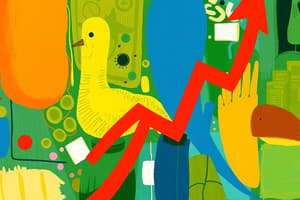Podcast
Questions and Answers
What is Gross Domestic Product (GDP)?
What is Gross Domestic Product (GDP)?
- The total value of exports minus imports of a country for a year
- The total value of all final goods and services produced in a country during one year (correct)
- The total value of all consumer spending in a country over five years
- The total value of all services only produced in a country during one year
Which component is NOT included in GDP calculations?
Which component is NOT included in GDP calculations?
- Exports minus imports
- The value of unpaid work performed at home (correct)
- Government spending on public services
- Business spending on new equipment
What does economic growth indicate?
What does economic growth indicate?
- A rise in government spending without accountability
- A decrease in consumer spending
- An increase in the production of goods and services (correct)
- A reduction in imports relative to exports
Which of the following best describes the category of consumer spending within GDP?
Which of the following best describes the category of consumer spending within GDP?
What is a common method for measuring economic growth over time?
What is a common method for measuring economic growth over time?
What does GDP per capita measure?
What does GDP per capita measure?
Which of the following can cause an increase in productivity?
Which of the following can cause an increase in productivity?
What is the main consequence of an economy moving into a recession?
What is the main consequence of an economy moving into a recession?
What phase of the business cycle is characterized by high employment and increasing GDP growth?
What phase of the business cycle is characterized by high employment and increasing GDP growth?
What is the unemployment rate a measure of?
What is the unemployment rate a measure of?
How does personal income contribute to economic growth?
How does personal income contribute to economic growth?
What factor does NOT influence economic growth?
What factor does NOT influence economic growth?
What typically follows a recession in the business cycle?
What typically follows a recession in the business cycle?
Which of the following is NOT a characteristic of a depression?
Which of the following is NOT a characteristic of a depression?
What is the ripple effect in economic terms?
What is the ripple effect in economic terms?
Flashcards are hidden until you start studying
Study Notes
Gross Domestic Product (GDP)
- GDP measures the total value of all final goods and services produced in a country within a year.
- It is the most widely recognized indicator of economic growth.
- Economic growth reflects an increase in the production of goods and services.
- GDP measures can be compared year-to-year to assess economic performance.
Components of GDP
- Consumer Spending: Includes expenditures on essentials like food, clothing, housing, and other goods.
- Business Spending: Investments in buildings, equipment, and inventory by businesses contribute to GDP.
- Government Spending: Expenses related to employee salaries and goods/services procured by the government.
- Net Exports: Calculated as exports minus imports, also factored into GDP.
- Certain activities are excluded from GDP, such as:
- Self-performed work (e.g., lawn care, home repairs).
- Intermediate goods that could lead to double counting.
GDP Comparison
- Higher production indicates a healthier economy, but total monetary value alone can be misleading.
- GDP per Capita: Calculated by dividing GDP by the population; a rise indicates growth, while a decline suggests struggles.
Labor Activities
- Labor generates goods and services, and wages create consumer demand through spending.
Employment
- The labor force in the U.S. is over 160 million people, composed of those aged 16 and over looking for work.
- Individuals not seeking employment (students, retirees) are not counted in the labor force.
- The unemployment rate indicates the percentage of the labor force that is jobless, an important economic metric.
- Unemployment primarily results from decreased demand for goods and services.
Productivity
- Productivity measures output per worker, heavily influencing economic growth.
- Factors contributing to productivity increases include capital resources, worker training, and management improvement.
- Declines in productivity can stem from poor working conditions or low morale.
- If wage increases outpace productivity, production costs rise, leading to inflation.
- Productivity gains can elevate living standards, allowing for reduced working hours.
- Specialization of Labor: Focus on specific tasks, promoting efficiency through division of labor.
Consumer Spending
- Consumer spending is crucial for economic stimulation, impacting overall growth.
Personal Income
- Encompasses salaries, wages, investment income, and government transfers to individuals.
Retail Sales
- Reflect both durable and nondurable goods purchases, indicating consumer spending trends.
- An increase in retail sales generally signals economic growth.
- Key retail categories include automobiles, building materials, clothing, and food.
The Business Cycle
- The economy experiences cycles of growth and contraction, known as the business cycle.
- Phases of the Business Cycle:
- Prosperity: High employment, increased production, rising wages, and GDP growth.
- Recession: Reduced demand leads to decreased production, rising unemployment, and a decline in GDP for two consecutive quarters.
- Depression: Severe and prolonged economic downturn with high unemployment and weak sales. Not experienced since the Great Depression (1930-1940).
- Recovery: Rising employment and demand post-recession, signaling economic improvement.
Studying That Suits You
Use AI to generate personalized quizzes and flashcards to suit your learning preferences.




